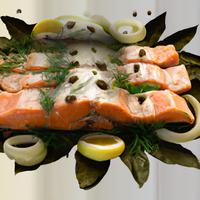
1 serving (100 grams) contains 206 calories, 22.0 grams of protein, 13.0 grams of fat, and 0.0 grams of carbohydrates.

Log this food in SnapCalorie

Nutrition Information
Calories |
490.5 | ||
|---|---|---|---|
% Daily Value* |
|||
| Total Fat | 31.0 g | 39% | |
| Saturated Fat | 7.4 g | 37% | |
| Polyunsaturated Fat | 0 g | ||
| Cholesterol | 150 mg | 50% | |
| Sodium | 140.5 mg | 6% | |
| Total Carbohydrates | 0 g | 0% | |
| Dietary Fiber | 0 g | 0% | |
| Sugars | 0 g | ||
| protein | 52.4 g | 104% | |
| Vitamin D | 1357.1 mcg | 6785% | |
| Calcium | 21.4 mg | 1% | |
| Iron | 1.2 mg | 6% | |
| Potassium | 864.3 mg | 18% | |
* Percent Daily Values are based on a 2,000 calorie diet. Your daily values may be higher or lower depending on your calorie needs.
Food Attributes
Source of Calories
About Salmon with skin
Salmon with skin is a popular seafood choice celebrated for its rich flavor, nutritional benefits, and versatility in cooking. Originating from cold-water regions like Alaska and Norway, salmon is commonly featured in cuisines worldwide, including Japanese, Scandinavian, and North American dishes. Leaving the skin on during preparation enhances crispness and preserves vital nutrients. Salmon is a powerhouse of omega-3 fatty acids, high-quality protein, vitamin B12, vitamin D, and essential minerals like selenium. The presence of omega-3s supports heart health, brain function, and inflammation reduction. The skin itself contains additional nutrients and collagen, beneficial for skin and joint health. While salmon is generally considered heart-healthy, moderation is key due to its fat content and, in some cases, potential exposure to environmental contaminants like mercury. Baking, grilling, or pan-searing salmon with skin are excellent methods to enjoy its flavor while retaining its healthful properties.



